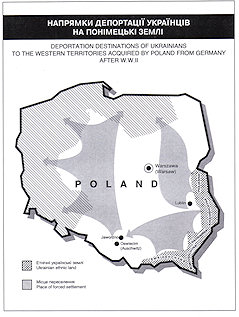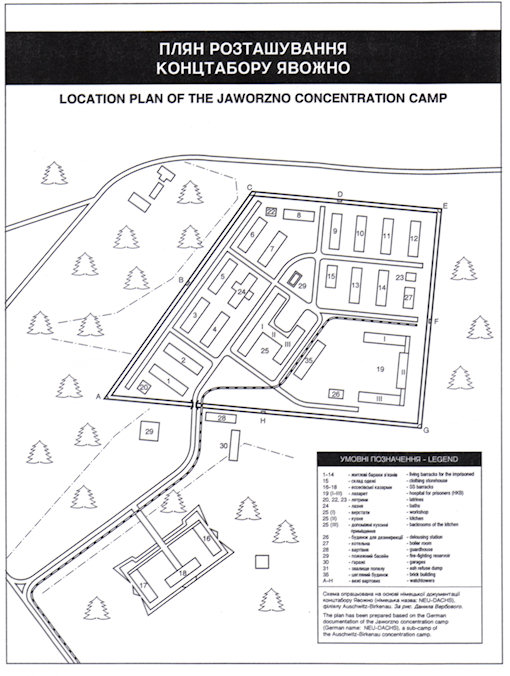HOLOCAUST VISTULA OPERATION- "AKCJA WISLA"
|
|
|
The project of en-masse transport was handed over to comrades Spychalski
and Radkiewicz. The designated duration of the project was one week.
Already from the middle of April, 1947, the territories of Sianik
and Lisko were being occupied by army echelons. They set up posts
in train stations, while soldiers were ordered to cut down and burn
forests and villages. These were elite battalions from all over
Poland, which were assigned to "Vistula Operation". Interestingly,
the train wagons emptied by the battalions did not get sent back,
but were left at the stations on the side rails. The reason why
this was the case became clear when on April 28, 1947 at 4 o'clock
in the morning, army battalions began to besiege villages. Once
they were surrounded by the forces, the village elder was informed
that all inhabitants should get ready to be deported. They were
given in general 2 hours and were lead out by a convoy, taking with
them very few of their belongings. If forces were met with resistance
they set whole villages on fire. Also, they brought destruction
to hundreds of churches. The churches that were left standing were
being used by Roman Catholic Parishes.
The deportees were accompanied by the numerous army forces to the
train stations, where they were herded behind barbed wire. Functionaries
of the Ministry of Defence, along with army personnel, sought out
and arrested many people under suspicion of being collaborators
of OUN or UPA organizations. Alleged collaborators were arrested,
subjected to brutal interrogations and beaten. Some were released
while the rest ended up in the Jaworzno concentration camp. The
first transport left on April 29, 1947 from Komancha and Kuliashne
Sianik region train stations.
The operating group responsible for the implementation of "Vistula
Operation" included the 3-rd, 6-th, 8-th and 9-th divisions
of infantry. In all there were 15 regiments. Also assigned were:
the division of the interior defence corps, consisting of 3 brigades;
a regiment of combat engineers composed of 310 transport trucks;
the 12-th regiment of the infantry and a division of militia composed
of 700 men as reserves of the commander of the operation group;
the aviation squadron Dovhlias and 9 PO-2, 4 armoured trains and
other specialized subdivisions. All together in excess of 20,000
well-trained militia, railway patrol, national defence patrol, and
border patrol forces took part. The first phase of "Vistula
Operation" lasted from April 27, 1947 to the end of May, 1947.
At this time approximately 50,000 Ukrainian civilians were exiled
to western Polish territories.
The second phase, during June, 1947 had as its focus the evacuation
of Peremyshl and Lubachiv regions, as well as Yaroslav and Tomashiv.
The 6-th, 7-th and 9-th divisions were assigned to carry out the
operation, aided by independent army individuals from the "Vistula
Operation" group.
In the third phase, during July, 1947 deportations were carried
out in Novy Sanch and Novy Targ of Krakow region, and also in Kholm,
Volodava, Hrubeshiv and Tomashiv of Lublin region. During "Vistula
Operation" a military curfew of 9 p.m. to 4 a.m. was in effect
in all affected regions. As well, outposts were established at passage
ways into cities and villages, and the rail way stations were well-guarded.
According to data collected by A. Szczesniak, the "Vistula
Operation" group deported some 95,846 people from Rzeszow county,
and 44,728 people from Lublin county: collectively 140,574 Ukrainians.
Not included in this total are data regarding deported Ukrainians
from Novy Sanch and Novy Targ of Krakow county. All together, more
than 150,000 people were deported.
Jaworzno
Almost all transports of deportees, even those from Kholm or Hrubeshiv,
passed through Oswiecim. This main junction which, was established
during the war, was the point of departure for many transports.
Many deportees were arrested here and led under army escort to the
Jaworzno concentration camp.
In Jaworzno, on the site of a Nazi concentration camp which was
closed in 1945, a special camp was organized in 1947 for the Ukrainians
of the "Vistula Operation". In the first days of its renewed
operation, the camp received its prisoners from Sianik. They consisted
of 22 catholic priests, 5 orthodox priests, doctors, teachers, and
the rest of the Ukrainian intelligentsia who survived all previous
attempts to stamp them out.
Jaworzno held 3,936 prisoners, of whom 823 were women, and between
10-20 were children. The court-martial of the "Vistula Operation"
handed down 133 death sentences, which were carried out from May
1 to July 31, 1947. After the completion of "Vistula Operation",
Jaworzno was used to imprison all deportees who tried to return
home from deportation. Due to tortures, malnutrition, unsanitary
conditions, the death count in Jaworzno was at least 150 people.
In Jaworzno concentration camp were registered few new born babies.
One of them was Stefan Dejneka, now resident of Toronto.
The camp was styled on Nazi-Bolshevik models, with watchtowers,
rifles, double barbed wire fences which were charged with a strong
electrical current. Although the Polish have erected monuments in
Oswiecim, where Auschwitz used to be, even trying to find any information
in Polish publications about camp Jaworzno during 1947-57 has proven
futile.
On the "Reclaimed Territories"
The first transports of deported Ukrainians began reaching their
destinations in the "Reclaimed Territories" (formerly
German lands) on May 4, 1947. Some transports took a circuitous
route which took 2-3 weeks.
The ministry of "Reclaimed Territories" issued several
directives which regard to the newly-arrived Ukrainians:
|
|
From the aforementioned, it is evident that the objective was quick
assimilation of Ukrainians into Polish nationality. This was in
keeping with original plans to denationalise all Ukrainians within
Poland.
Upon arriving, army commanders of the transport obtained full documentation
regarding each family. Included was an evaluation and characterization
of the families, who were divided into several categories. These
deemed most dangerous were located in the most remote places, where
there was no means of communication. The deported fell under the
responsibility of regional government of Defence and militia, and
some were at this time arrested.
The Polish populace was openly hostile towards Ukrainians and persecuted
them in many ways. A deportee was not allowed to change his place
of residence without permission. All who tried to return to their
native lands were imprisoned. In certain villages (Bytiv, for one)
it was forbidden to go to the neighbouring village and to work in
the forest without a special pass. Usually, Ukrainians were designated
to live in formerly German-owned, half-destroyed houses. Some got
farms while others were assigned to state-owned agricultural operations.
The first deportees had time to sow grain and plant potatoes. Those
who arrived at the end of May were too late for this. These people
came face to face with famine. The following was written about the
situation of Ukrainians in Szczecin and Gdansk regions and his deputy
of the II Army Battalion in Bydgoszcz:"The relocated
population finds itself in very difficult material circumstances.
All houses require renovations...In Gdansk region, where first transports
arrived after June 15, nothing is sown or planed..Generally, the
situation is very bad and worse are the prospects┘there is
a lack of funds to rebuild hoses, voucher provisions are insufficient
,the regional budget, despite the influx of this new population,
was not increased...".
In these dismal circumstances, Ukrainians had no choice but be hired
by their Polish neighbours and work for a pittance. As in the time
of serfdom, they were paid with a piece of bread or some potatoes
for their labour.
Even worse was the state of cultural life. All former familial and
community relations were severed. Inhabitants of a single village
were now peppered over great territories spanning several regions.
There was no Ukrainian education. Ukrainian books were forbidden
and destroyed. People had nowhere to worship because they had no
church. They had no spiritual guidance as almost all clergy were
arrested.
Final Thoughts
On June 3, 1990 the Polish senate condemned the criminal "Vistula
Operation" but despite efforts of many deputies, the Polish
Parliament has made no inquires into this matter to this day. Ukrainians
in Poland and elsewhere expect the Polish government to take steps
to heal the wounds on the collective body of the Ukrainian population
with compensation for the atrocities and injustices endured during
and as a result of "Vistula Operation". Similar crimes
to that of the "Vistula Operation" were perpetrated, during
World War II by the Stalin regime, on Crimean Tartars and Kavkazians.
In each case, the injustice was recognized by those responsible
and each group was compensated, first in 1956 by the Khrushchev
regime and then later by an independent Ukraine.
To date, all similar crimes have been condemned, the injustices
admitted to, and those that suffered compensated by the nations
whose regimes committed them. The only exception being the Polish
government, which still refuses to acknowledge the full extent of
it's involvement and injustices perpetrated vis-Ю-vis the
"Vistula Operation". The Polish government has made no
inclination to condemn its past acts of injustice nor has it made
any attempt to compensate those individuals that it has wronged.
Poland is a member of the United Nations and the European Union,
both organizations have condemned Nazi-Hitler and Communist-Stalin
atrocities perpetrated on several nations. The question asked is,
how long will the Polish government wait to admit its past injustices
and how long will the United Nations and European Union tolerate
the hypocrisy of the Polish government?
Maximilian Masley
Member of Commission on Human and Civil Rights of Ukrainian World
Congress
Victim of "Vistula Operation"
July, 2008
Literature:
1. Droga do nikad, 1973, A.B. Szczesniak, W.Z. Szota,
Ministry of Defence of Poland
2. Akcja "WISLA",1993, E. Misilo, Ukrainian Archives
3. Problemy Ukraincow w Polsce po wysiedlenczej akcji "Wisla",
1997, W. Mokry

